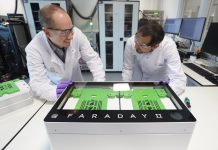
Upside Energy founder and chief scientist, Graham Oakes, offers a counter argument to recent suggestions by Kiwi Power CEO, Yoav Zingher, that the industry should crack large scale DSR before moving on to smaller scale flexibility.
Many people think industrial and commercial DSR is easier than micro business or domestic DSR. You just need to recruit a few big big sites. They make a material difference to overall load, so National Grid welcomes them with open arms. So it’s all an easy sell, and you grow from there. As Yoav says, it’s actually a lot harder than that.
Going back to basics, DSR is a two-sided thing — the energy system has to buy it, and the site has to want to sell it and be able to deliver it.
On the energy system side, it understands big sites. It’s used to dealing with large power plants, big transmission lines, etc. So selling large commercial and industrial DSR to it is indeed relatively easy. (It’s a lot easier now than it was 10 years ago; all credit to players like Flexitricity and Kiwi for making this market.)
But on the demand side, there are two huge barriers.
First, it takes a lot of work to encourage people to want to sell it — building awareness, persuading them that it’s not snake oil, etc. That’s particularly true on I&C sites: they have a lot of value at risk. If their industrial process isn’t worth more than the DSR value of their site, then they probably shouldn’t be in business anyway. So putting that process at risk for the sake of DSR revenue requires a lot of confidence that the DSR will work without a hitch.
And second, delivering that DSR is hard. Every I&C site is bespoke, built to the specific process and site requirements. So you need to do site audits, configure your kit to connect to the kit that’s onsite, integrate to the company’s information systems, etc. That’s a lot of work, both for initial set up and for ongoing support.
The situation is very different for domestic sites. Yes, the initial awareness building is very hard. The energy system is (sometimes unnecessarily) complex and people really don’t have time or inclination to get their heads around it. So there’s a big barrier to getting started. That’s why it’s taken time. But as you look at that barrier, you find ways to get past it. There are lots of firms out there that sell to consumers. (That’s why they’re called consumers.) So build the right channel partnerships, and you have a natural entry to begin building the story,
And the delivery story is very different. On domestic or micro business sites, you’re installing standard kit — every Sonnen battery is essentially the same, every Powervault, every Daikin heat pump. So integrate one, and you can connect to thousands. You can build operational processes for scale, automation and self-service. It’s a totally different, and much lower cost, operating model once you get beyond the initial barrier. One that, we think, is a lot easier to make money from.
Now we just need to get players like National Grid to buy domestic DSR. Because they really don’t understand it. They still need to make a big shift to their mindset to buy from small sites. But there are huge advantages to them to buy from small sites too.
The way I see it, the energy system is where IT was about 20 years ago. Then, if you wanted a large, fast, reliable disk drive, you bought a very expensive, bespoke bit of kit. Then someone worked out that you could do better with an array of smaller, cheaper, standardised disks. They called it RAID — redundant array of inexpensive disks — because using cheap, standard parts meant you could use lots of them and hence let the statistics work for you. So you got higher speed, more reliability, greater size, and all at a lower cost. The energy system is just on the start of this transition.
So large industrial DSR is harder than small DSR. It can’t exploit the standardisation, scale economies and statistics that domestic DSR can exploit.
We know, because we do both. And we’re pretty well the only player who does — we started from a focus on domestic, because that’s operationally easy provided you get the technology and operating model right. We then realised that, having got the economics right there, they worked even better with I&C, so we’ve moved into that too.
Interested in demand-side response and storage? We need end user views to create the research component for two new reports. Please take our short survey here.
Related stories:
Kiwi Power boss: forget small scale DSR until we get the big stuff right
Smart grid firm Upside Energy raises £5.5m
Upside Energy installing 1MW of batteries and hot water tanks to prove domestic DSR
Artificial Intelligence for smart grids: can UK start-up beat Google?
Aggregator targets small firms to build DSR from bottom up
Should Ofgem consider derating DSR plus storage? Aggregators weigh in
Follow us at @EnergystMedia. For regular bulletins, sign up for the free newsletter.



